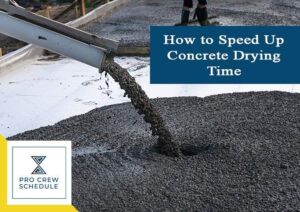When it comes to managing construction projects, concrete drying time is one major factor that affects the schedule. When concrete is used, time is always consumed by waiting for the mixture to dry and cure. If you tend to rush and don’t wait for the concrete to dry properly, this may result in structural failures, causing further project delays. Making sure concrete dries appropriately is one of the many tasks of a project manager. That is why it is crucial to find ways how to speed drying time.
To boost your projects’ efficiency, it is crucial to look for ways of speeding up the concrete curing and drying times to ensure both timekeeping and safety are catered for. Shortening the drying time can save a lot of money. This blog will share some practical concrete pre-pour and post-pour tips for faster drying time.
What is the Main Difference between Drying and Curing?
The terms drying and curing are frequently used interchangeably when it comes to new concrete slabs’ moisture conditions. However, concrete drying and concrete curing are two different processes. Curing concrete is the process of hardening that starts quickly after the concrete is being poured. The process may usually take twenty-eight days or more to complete.
Even after the concrete is already cured, excess water should still evaporate from the concrete. While it may take twenty-eight days to cure concrete, drying concrete can take months. To better track the concrete’s progress, concrete contractors should specifically use subcontractor scheduling software like Pro Crew Schedule. This software solution tracks not only overall progress but also provides real-time updates to you and your team.
Pro Crew Schedule is the leading software solution designed for your construction business. Try to experience the live demo and request it for FREE!
How Concrete Cures
There are several concrete types, but they all comprise three essential components – aggregate, water and cement. Read more about the process of curing concrete of our blog Curing Concrete: Role, Necessity and Functions.
When cement and water are mixed, a chemical reaction will typically occur, binding the components altogether. The process is what causes concrete to harden. During the process, the concrete quickly becomes porous. As a result, a certain amount of water will become a part of the concrete. The water that’s left will either evaporates or remain in the concrete capillaries.
How Concrete Dries
Drying of concrete refers to the process of providing proper conditions that allow concrete to achieve the suitable moisture condition for its intended use.
Concrete dries when the water within it evaporates through the surface. When water evaporates through the surface, the water within the concrete will move through the capillaries, going up to the surface to eventually replace it. For as long as the surrounding air is capable of holding water vapor, evaporation continues. Otherwise, evaporation or drying of the concrete may stop if the surrounding air cannot have more water vapor.
Speeding Up Drying: Before the Pour
There are many things you can do before you start pouring the concrete. By following the tips below help you speed up the drying process.
1. Choose the perfect weather
Science proves that anything dries faster in drier, warmer conditions, which is why sunnier days are an ideal time for concrete drying. If you’re going to wait until summertime, it is the best option for you and your current projects. Project schedules aren’t affected if you’re going to be wise in choosing the ideal alternative. Hence, wait and choose for the perfect weather.
2. Add calcium chloride
Including calcium chloride into the wet concrete mix before even pouring is a convenient way to speed up the concrete solidification time. This particular compound speeds up the process of cement hydration. You can also utilize a high cement content mix to shorten the drying time. However, there can be many risks of cracking due to shrinkage.
If it is possible, never use sealing, curing or any bond-breaking agents. They can prevent evaporation from the concrete’s surface, thus, increases the drying time.
3. Add warmer water
Use the right amount of water in the mix. As one of the main ingredients of concrete, water is vital for the curing response to happen. The curing time can be hastened by using warmer water in the mixture. It will then encourage the reaction to occur faster. Remember, do not utilize hot water as it can be more damaging.
4. Reducing the amount of water
It’s just basic science. The more water you’ll add to the concrete mixture, the longer it will take to set. Using lesser water will reduce the drying time. However, be cautious not to put too little water as it can make the concrete mix too inflexible and thicker.
To get the balance right, an alternative should be used. By adding water-reduces, the substance will give the mix more fluidity without hindering it with excess water.
Speeding Up Drying: After the Pour
Once new slabs occur, make sure to enclose the space as soon as possible. Doing so will protect the slab from absorbing any unnecessary moisture. While protecting the slabs from additional moisture is a vital step, other several factors can affect drying time after the pour:
- The temperature of the slab
- The ambient relative humidity and air temperature
Speaking of ambient relative humidity, it is crucial because it can control whether water evaporates from the slab or not. If the ambient humidity gets higher, the slab may not dry. Enclosing the space allows you to utilize HVAC to control ambient conditions fully. HVAC systems serve as a refrigerating dehumidifier and will typically maintain a fifty percent relative humidity level in cooling mode. This level is ideal for drying your concrete. In heating mode, HVAC systems lower the relative humidity level by raising the air temperature.
Here are some tips for speeding up drying time during post-pour:
1. Troweling Technique
The concrete contractor should avoid hard troweling – the increased pressure may cause several issues. However, high-intensity troweling may cause densification of the concrete, subsiding vents and air pockets. Therefore, avoiding the moisture from quickly evaporating when drying, therefore, extending the drying time.
2. Cover it using a plastic sheet
Curing often requires moisture to be enhanced. One way of guaranteeing this is to lay some plastic sheets over the laid concrete mix. Doing so will prevent the moisture from escaping and stop additional water from entering. Therefore, slowing down the drying time even more.
3. Use a heater
Does the weather not in your favor? Hence, it would help if you started creating your heat using artificial means – hearing mats or heater. If you prefer using a heater, be wary not to overheat the wet concrete mix. With a gentle amount, it gives your concrete the enhancement it needs to speed up the drying time.
How Do You Know When Concrete Is Finally Dry?
You don’t unless if you’re going to test it first. If you’re lucky, it will be dry right away. However, in many cases, it won’t be. Hence, you’ll have to give more time to let the concrete dry before testing it again. How much time you will spare to dry before another test is the best guess based upon past experience. The slab is dry enough to receive the floor covering at some point. The entire process can be unpredictable for concrete contractors like you. Schedules may slip and costs can mount up.
But there are solutions for such instances. When you must install the floor covering and the drying process isn’t complete yet, you can utilize a moisture mitigation system. If you use this particular route, make sure to pick a high-quality product that will sufficiently seal the moisture into the slabs. It is also practical to implement project management for construction so that it’ll easier for you to track the drying process of concrete.
When testing the concrete for dryness, make sure to:
- Use the procedure called the “relative humidity test” which specifically use situ probes. The procedure is the primary basis for the ASTMM F2170 standard.
- Utilize sensors during testing. Sensors are inserted into the concrete at exact depths to precisely measure the air’s relative humidity currently trapped in the concrete.
- The sensors are inserted to forty percent depth of the slab’s thickness when only one side of the slabs has dried.
- · For slabs drying equally on both sides, the sensors will be inserted to twenty percent depth of the slab’s’ thickness.
- Once sensors are already installed within the slab and equilibrated for twenty-four hours, you can repeatedly take moisture readings.
Presently, a particular technology is now available that add science to the art of foreseeing concrete drying time. It is called Data Logging. This technology involves installing small devices within the concrete. The devices installed can continually track concrete moisture levels, including the relative humidity and ambient temperature. The collected data is stored in the memory, allowing you to download it via your smart device easily.
Key Takeaways
These were some of the concrete pre-pouring and post-pouring tips to further improve the concrete’s drying time process. While the natural drying time isn’t always enough, the above-mentioned practical tips help set concrete quickly, attaining the desired dryness and strength.







